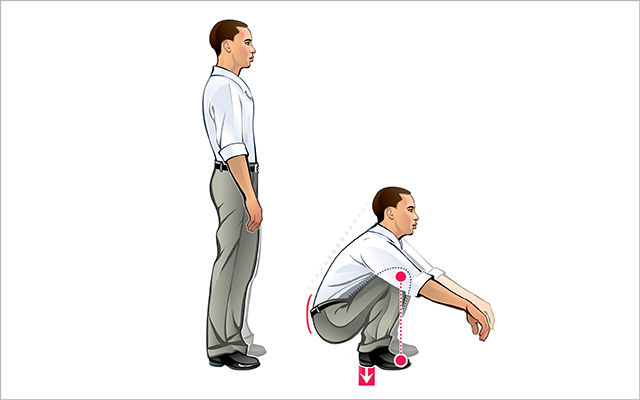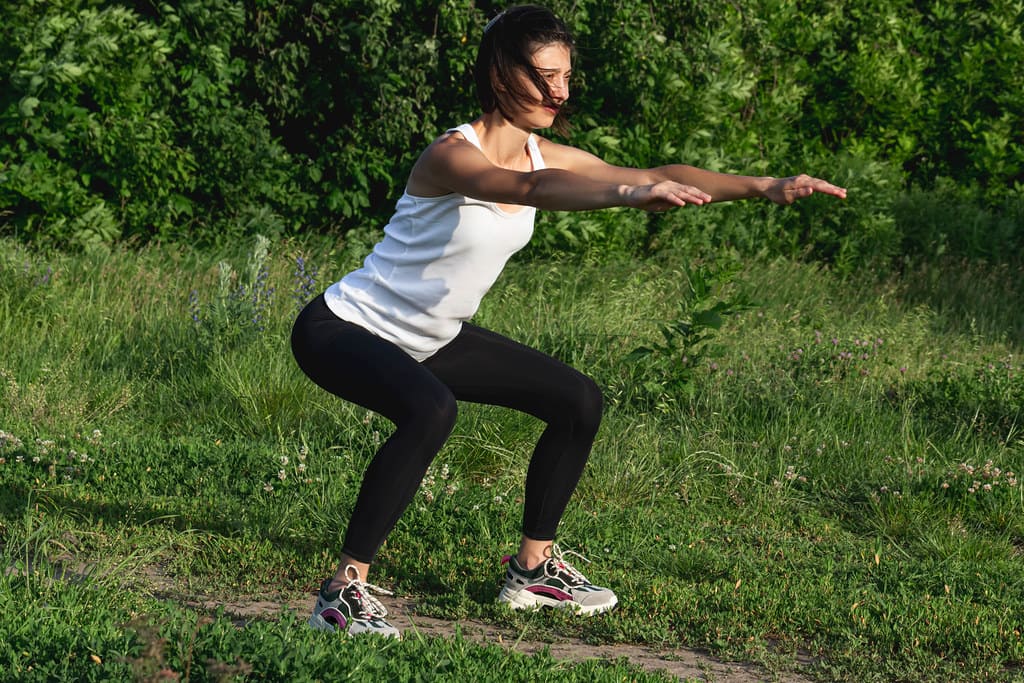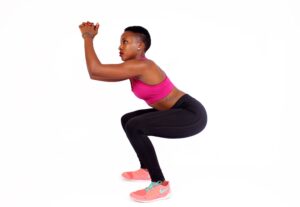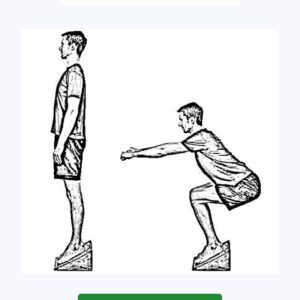
Qigong wall squats are a variation of the traditional squat exercise that combines the principles of Qigong, a Chinese practice that focuses on the cultivation of energy and internal strength, with the physical benefits of squats. By incorporating Qigong elements into wall squats, this exercise offers a unique approach to building strength, flexibility, and balance.
In this article, we will explore the ten benefits of Qigong wall squats, provide you with practical tip to optimize the benefits of Qigong wall squats and finally tell you how to do the exercise with proper form for minimum risks and optimal benefits
What are the Benefits of Qigong wall Squats?
The benefits of Qigong wall squats are:
- Strengthens Lower Body Muscles
- Improves Flexibility and Range of Motion
- Enhances Core Stability
- Promotes Energy Flow
- Cultivates Mindfulness and Relaxation
- Develops Endurance and Stamina
- Supports Joint Health
- Improves Posture and Alignment
- Enhances Mind-Body Connection
- Accessible for All Fitness Levels
Now we will provide you details on these ten benefits of Qigong wall squats
Benefit #1. Strengthens the Lower Body Muscles
Qigong wall squats specifically target the muscles of the lower body, including the quadriceps, hamstrings, glutes, and calves. By holding a static squat position against a wall, you engage these muscles for an extended period, resulting in increased strength and endurance.
Benefit #2. Improves Flexibility and Range of Motion
Performing Qigong wall squats requires maintaining a deep squat position. This helps to improve flexibility in the hips, knees, and ankles. Over time, regular practice can lead to increased range of motion in these joints, making everyday movements easier and reducing the risk of injury.
Benefit #3. Enhances Core Stability
Maintaining proper posture and alignment during Qigong wall squats requires strong core engagement. The core muscles, including the abdominal muscles and back muscles, work together to stabilize the body in the squat position. Improved core stability can lead to better balance and posture in daily life.
Benefit #4. Promotes Energy Flow
Qigong principles emphasize the cultivation and circulation of vital energy, known as Qi. By combining Qigong techniques with wall squats, you can enhance the flow of energy throughout the body. This can lead to a sense of vitality, improved overall well-being, and a harmonious balance between mind and body.
Benefit #5. Cultivates Mindfulness and Relaxation
Qigong wall squats encourage a mindful approach to movement and exercise. As you hold the squat position, you can focus on deep breathing, relaxing the body, and quieting the mind. This promotes a sense of relaxation, reduces stress, and enhances mental clarity.
Benefit #6. Develops Endurance and Stamina
The prolonged isometric contraction involved in Qigong wall squats challenges your muscle endurance. By gradually increasing the duration of your squat holds, you can improve your stamina over time. This can be beneficial for various physical activities and sports that require prolonged muscle engagement.
Benefit #7. Supports Joint Health
Qigong wall squats are low-impact exercises that place minimal stress on the joints. The controlled movement and focus on proper alignment help to strengthen the muscles around the joints, providing increased support and stability. This can be particularly beneficial for individuals with joint issues or those recovering from injuries.
Benefit #8. Improves Posture and Alignment
Maintaining correct posture is essential during Qigong wall squats. This exercise promotes proper alignment of the spine, hips, and knees, which carries over to improved posture in daily life. By strengthening the muscles that support good posture, you can alleviate pain and discomfort associated with poor alignment.
Benefit #9. Enhances Mind-Body Connection
Qigong wall squats emphasize the connection between the mind and body. Through focused breathing, concentration, and body awareness, you can develop a deeper understanding of your body’s movements and sensations. This enhanced mind-body connection can lead to improved coordination and overall physical performance.
Benefit #10. Accessible for All Fitness Levels
Qigong wall squats can be modified to suit various fitness levels and physical abilities. By adjusting the depth of the squat or the duration of the hold, individuals of all fitness levels can benefit from this exercise. It provides a gentle and accessible way to build strength and flexibility, making it suitable for beginners and experienced practitioners alike.
Additional Qigong Wall Squats Benefits

Here are seven more benefits of practicing Qigong wall squats regularly:
- Enhances Circulation: The deep squat position in Qigong wall squats helps to promote blood circulation throughout the body. Improved circulation can aid in the delivery of oxygen and nutrients to the muscles, tissues, and organs, supporting overall health and vitality.
- Boosts Digestion: The compression of the abdominal area during Qigong wall squats can stimulate the digestive system. This can help improve digestion, relieve bloating, and support a healthy metabolism.
- Increases Bone Density: Weight-bearing exercises like Qigong wall squats can contribute to increased bone density. By placing stress on the bones, this exercise helps stimulate bone remodeling and can be beneficial for preventing osteoporosis and improving bone health.
- Stimulates the Lymphatic System: The squatting motion in Qigong wall squats can help stimulate the lymphatic system, which plays a crucial role in immune function and detoxification. Improved lymphatic flow can enhance the body’s ability to eliminate toxins and waste products.
- Improves Balance and Stability: Holding a static squat position against the wall challenges your balance and stability. Regular practice of Qigong wall squats can improve proprioception (awareness of body position) and strengthen the muscles responsible for maintaining balance, reducing the risk of falls.
- Supports Pelvic Floor Health: The deep squat position in Qigong wall squats engages the muscles of the pelvic floor. By strengthening these muscles, this exercise can help improve pelvic floor function, which is important for urinary and bowel control, as well as sexual health.
- Promotes Mindful Eating: Incorporating Qigong wall squats into your routine can promote mindful eating habits. By cultivating mindfulness and a deeper mind-body connection through this exercise, you may become more aware of the signals of hunger and fullness, leading to healthier eating habits and improved portion control.
- Traditional Chinese Medicine benefits: Qigong wall squats stimulate, open, and clear blockages from the kidney meridian channels, the ren and du meridian channels, and other acupuncture points, aiding in the circulation of qi around the body.
- Stress reduction: It can be used as a way to reduce stress
By enjoying the various benefits of Qigong wall squats, you can enhance your physical and mental well-being, support your overall health, and cultivate a harmonious balance between mind, body, and spirit.
Tips for Maximizing Qigong Wall Squats Benefits
Here are some tips for maximizing the benefits of Qigong wall squats:
- Proper Alignment: Ensure proper form and alignment during Qigong wall squats. Stand with your feet shoulder-width apart, toes pointing slightly outward. Keep your back straight, shoulders relaxed, and knees aligned with your toes. Avoid leaning too far forward or backward.
- Gradual Progression: Start with a comfortable duration and gradually increase the time you spend in the squat position. Begin with 30 seconds and work your way up to a few minutes as your strength and flexibility improve. Listen to your body and avoid pushing yourself too hard.
- Focus on Breathing: Pay attention to your breath while performing Qigong wall squats. Breathe deeply and smoothly, inhaling through your nose and exhaling through your mouth. Let your breath flow naturally and use it to help you relax and release tension.
- Mind-Body Connection: Cultivate a mindful connection between your body and mind during Qigong wall squats. Pay attention to the sensations, thoughts, and emotions that arise. Stay present and fully engaged in the exercise, allowing yourself to experience the benefits on a deeper level.
- Stretch and Warm-Up: Before starting Qigong wall squats, warm up your body with some light stretching exercises. Focus on stretching the lower body, including the hips, thighs, and calves. This can help prepare your muscles and joints for the squatting position.
- Use Support, if Needed: If you find it challenging to maintain the squat position against the wall, you can use props for support. Place a yoga block or cushion under your heels to elevate them slightly, reducing strain on the knees and ankles. Gradually decrease the support as your strength and flexibility improve.
- Consistency is Key: Practice Qigong wall squats regularly to experience the maximum benefits. Aim for at least three to four sessions per week. Consistency allows your body to adapt and improve over time, increasing strength, flexibility, and overall well-being.
Qigong Wall Squats Proper Form for Maximum Benefits and Minimum Risks
Proper form is essential when performing Qigong wall squats to maximize benefits and minimize the risk of injury.
Here’s a step-by-step guide to help you maintain proper form:
- Stand with your feet shoulder-width apart, toes pointing slightly outward. Find a wall or sturdy surface to lean against.
- Slowly lower your body into a squatting position, bending your knees and hips. Keep your back straight and your chest lifted. Avoid rounding your shoulders or hunching forward.
- As you lower into the squat, aim to bring your thighs parallel to the floor. If you’re new to this exercise or have limited flexibility, it’s okay to squat to a comfortable depth.
- Ensure that your knees are aligned with your toes and not collapsing inward. This helps to maintain proper knee alignment and prevents unnecessary strain on the joints.
- Engage your core muscles by gently drawing your navel toward your spine. This helps to stabilize your torso and maintain balance throughout the exercise.
- Maintain an even distribution of weight on your feet, with the heels grounded and the balls of your feet pressing into the floor. Avoid lifting your heels or shifting your weight too far forward or backward.
- Relax your shoulders and keep them away from your ears. Allow your arms to hang naturally by your sides or place your hands on your thighs for additional support.
- Focus on your breath. Take slow, deep breaths in through your nose, and exhale fully through your mouth. Let your breath flow naturally and use it to help you relax into the squat position.
- Hold the squat for a duration that feels comfortable for you. Start with a shorter duration, such as 30 seconds, and gradually increase the time as you build strength and flexibility.
- To come out of the squat, push through your heels and engage your leg muscles to slowly rise back to a standing position.
It’s important to listen to your body and modify the exercise as needed. If you experience any pain or discomfort, reduce the depth of the squat or consult with a qualified instructor for guidance.
Additionally, if you have any pre-existing medical conditions or injuries, it’s advisable to seek professional advice before starting any new exercise program.
Qigong wall squats offer a unique blend of physical and energetic benefits. By practicing them with proper form and incorporating the tips mentioned, you can optimize the benefits of this exercise while minimizing the risks. Enjoy the strength, stability, and energy flow that Qigong wall squats can bring to your practice.
Related Posts
Citations:
[1] https://earthbalance-taichi.com/2022/04/qigong-wall-squatting/
[2] https://youtube.com/watch?v=5YKtIFD8Ce8
[3] https://cynthiamcgilvray.com/2011/07/02/qi-gong-and-the-benefits-of-wall-squats-zhineng/
[4] https://www.thedaobums.com/topic/49918-what-are-all-the-benifits-of-wall-squats/
[5] https://youtube.com/watch?v=0UxfKzEaJrE
[6] https://www.chilel.com/new08-2001/a_quick_guide_to_wall_squatting.htm
[7] https://renxueamericas.org/qigong-squats/



























